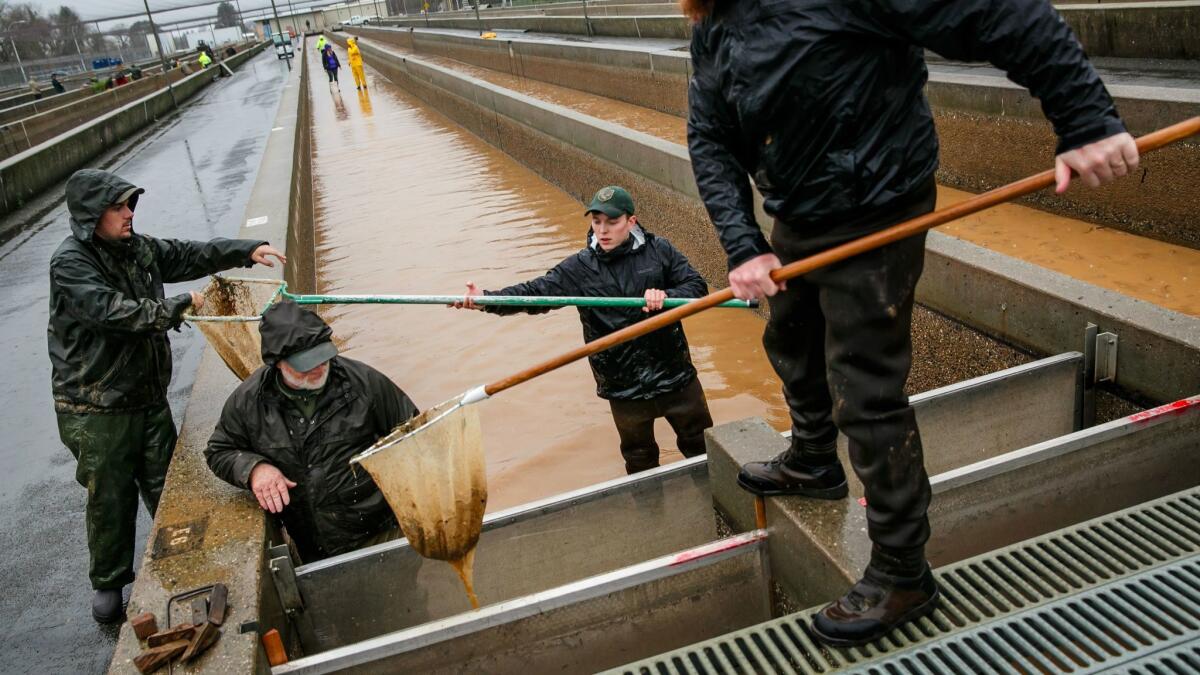Capitol Journal: Here’s why we should think about protecting California fish

Reporting from Sacramento — Memorial Day marks the unofficial start of summer. And one thing that means is trout fishing.
Especially this summer, because the five-year drought has mercifully ended. Streams are leaping off the mountains in whitewater cascades, carrying bug buffets to fish lurking in deepwater pools. Cold-water lakes are chock-full.
Trout and their cousin salmon, caught off the coast and savored grilled or smoked, are among California’s most prized assets. They and another cousin, the majestic, ocean-going steelhead trout, are three things that make this state a special place to live.
We’re fortunate to have what’s left. We used to have much more. And, if the trend continues, we’ll have a whole lot less in the future.
Fishery biologists at UC Davis and California Trout, a nonprofit activist organization, issued a 100-page report recently, and its conclusions were alarming. It predicted that three-fourths of California’s trout, steelhead and salmon species will become extinct in the next 100 years. Within 50 years, nearly half will die off.
The biologists lump these related species under one name, salmonids, and call them “the iconic fishes of the northern hemisphere.”
The salmon and steelhead are anadromous. That is, they’re hatched in freshwater, swim out to sea for a while, then return to the rivers of their hatching to spawn offspring. California has 21 such species.
Why do they hang out in the ocean? “To get large. If you’re a bigger fish you can lay more eggs and have more babies,” says Patrick Samuel, conservation director for California Trout and one of three biologists on the study.
“This has allowed them to evolve and survive. Salmon go out to sea to get fat on marine nutrients that they can’t get in fresh water. All those nutrients normally wouldn’t be available in rivers, but the salmon bring some back to jump-start their young.”
Of course, the salmon die after spawning. That fertilizes the rivers and plants. And it feeds the bears and other animals. It’s amazing how nature works all this out — until humans muck it up.
The steelhead spawn and live on. They beat it back to sea and return once or twice more to mate and reproduce.
As for the strictly freshwater trout, there are 10 species in California.
“California has the greatest diversity of salmonid species of any state in the lower 48,” Samuel says. “That’s due to the unique geology and climate. There are lots of different climates. And lots of elevation change.
“The fish have different life strategies. They don’t put all their eggs in one basket. Central Valley Chinook salmon, for example, have four different spawning runs so they don’t all get wiped out if a natural disaster happens, like an earthquake or a master flood that scours out a riverbed.”
But, Samuel adds, “as you might expect, their abundance has been declining significantly — for salmon and steelhead in particular.”
Why? “Largely because of what we’ve done to California’s landscape,” he says, mainly by building dams that block salmon and steelhead from their historic spawning waters — such as huge Shasta on the Sacramento River or little Matilija on the Ventura.
When I was a kid in Ojai, my dad used to routinely catch steelhead in the Ventura River. That ended after Matilija Dam was built. But the reservoir soon silted up with crud. Local groups have been searching for $80 million to tear it down.
Samuel estimates that 95% of Southern California’s steelhead have disappeared. The Santa Ynez River in Santa Barbara County used to host 20,000 spawning fish annually. Now there may be a handful.
In Northern California, there are still sizable runs, but they’re greatly reduced from the glory years.
“The Sacramento and San Joaquin rivers historically supported up to a million Chinook salmon a year,” Samuel says. “So many there actually were canneries on San Francisco Bay. Now we’re nowhere close to that.”
Blame also water diversions for irrigating orchards in the San Joaquin Valley.
Agriculture interests scream that government wastes water by letting it flow to the sea. But if water doesn’t flow to the sea, neither do salmon and steelhead. And that kills the coastal fishing industry.
As for California’s state fish, the golden trout, 50 years ago there were an estimated 40,000 enjoying their native range in the southern Sierra. Now there are only somewhere between 400 and 2,600, the study found.
But “the major, overarching” threat to all these cold-water critters is global warming, the report warns.
What can be done? The report calls for not making things worse by at least protecting what’s left of our best fish waters.
Also, try to restore waters that were lost generations ago, such as flood plains. Flooded rice fields, where fish can eat themselves silly, now are helping with that.
In addition, tear down useless dams like Matilija. And provide passage around useful dams.
Most important: Get political leaders — not just wildlife managers — to give a rip.
“It’s a very concerning trend,” Samuel says. “But these fish are incredibly resilient. Given half a chance, they will survive. They made it through the drought. Now we need to double-down and be more innovative.”
I’ve always liked the old Babylonian proverb: “The gods do not deduct from man’s allotted span the hours spent in fishing.”
But there need to be fish to catch.
Follow @LATimesSkelton on Twitter
ALSO
Single-payer healthcare in California? Time to take a cold shower and return to the real world
More to Read
Get the L.A. Times Politics newsletter
Deeply reported insights into legislation, politics and policy from Sacramento, Washington and beyond. In your inbox three times per week.
You may occasionally receive promotional content from the Los Angeles Times.











